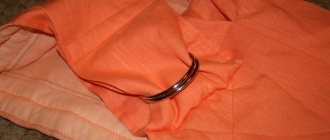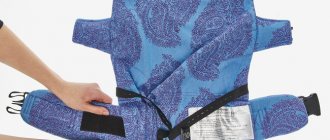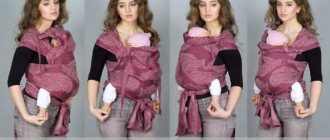With the development of the popularity of the sling - a fabric bandage designed for carrying newborn babies - a lot of problems have been solved for parents. If you know how to use a sling, you can organize safe and comfortable carrying of babies, simplify the process of feeding them (especially in public places), and ensure constant contact between the mother or father and the baby.
When choosing a suitable product, beginners are advised to pay special attention to models with rings. They are not so difficult to put on, you can tie them in several ways and not worry about the reliability of fastening. For beginners, there are detailed instructions that allow you to avoid common mistakes and get the maximum benefit from the functional device.
Ring sling - what is it?
A sling is a fabric 60-70 cm wide and up to 2 m long, created for the comfortable movement of a woman with a child. One side of the fabric has a ring and lining, the second side is used to adjust the required length.
The device allows you to sit the child in any position virtually in the woman’s arms. To avoid stress on one side of the muscular system, it is necessary to periodically change the position of the baby and change the shoulder in order to comfortably wear the sling.
The positive side of using this type of device is the freedom of action of the mother, since her hands are freed from the burden. If the child is used to being held, then a sling is the most suitable device; in it, a newborn or a newborn will sit comfortably, while feeling maternal warmth and calm.
If you wear the sling correctly, the newborn or newborn will take the most comfortable position, and there will be no harmful effects on the children's muscles. Slings are very comfortable and easy to use. However, there is also the other side of the coin: due to the constant carrying of the child in front of him, there is a load on the musculoskeletal system of the parent, and the risk of injury for the child increases sharply.
Materials for a sling scarf
When choosing fabric carriers, great importance is attached to the materials from which they are made. This is an important factor, since failure to properly wrap the scarf can harm the baby.
Ergo backpack for newborns - rules of use
Importance is given to the plasticity of the fabric, its ability to allow air to pass through and hold the winding stably, therefore it is recommended:
- If the child is very small, focus on the softness of the fabric, for example, a scarf;
- When the baby grows up and becomes heavier, a denser fabric, mixed with linen or cotton, will be suitable;
- A winding made of fabric with the addition of silk or bamboo will be thin and pleasant to the touch.
For your information! Consultants warn that silk scarves are difficult to wear, care for, and wind, as they slip. Therefore, if a novice mother has not yet mastered the ability to wrap a sling, it is better to start with cotton.
- A knitted scarf is good for the first sling, but it has its own characteristics. You need to wind and tighten knitwear no less carefully than cotton fabric. In addition, a scarf sling needs a three-layer winding, but it can be hot for the baby. The advantage of the device is increased softness, which does not irritate the baby’s skin.
How to put on a sling correctly?
To ensure a safe walk, you must put on and wear the sling correctly. It is fastened according to this principle: the lower edge of the fabric is threaded through one ring and put on the shoulder. If you put the sling on your right shoulder, the ring will be on the left side. The same rule applies to the left shoulder.
The fabric should cover the mother's shoulder without stretching or cutting into the neck. This is important, because when placing a child in a sling, the burden will put stress on the shoulder, causing pain. After the child sits in the device, the fabric must be carefully straightened on all sides, taking a more comfortable position for movement.
Comparison table of both types of slings
Based on the above data, our recommendations for using slings will be as follows:
- It is better to buy two types of carriers
, because they will complement each other in different situations. A sling scarf will become an indispensable assistant during long walks, and a sling with rings is suitable for use at home and a short trip to the store or clinic. - If you decide to purchase one carrier
, then
a sling scarf will be the best choice.
You can wear it on a trip, or knit it when you need to quickly rock your baby to sleep. Each company complements the scarf slings with a special insert. The instructions allow you to master all sorts of types and methods of fixation, choosing the most optimal one for yourself. - Only a sling with rings
if you plan to use it
for short
and short walks, for feeding, or rocking to sleep. It will act as a carry-on carrier.
How to carry a baby correctly?
To make it comfortable to wear a sling, you need to sit the baby down correctly, otherwise there is a risk that the baby will fall. A newborn or newborn is placed in a sling according to the following rules:
- In the “column” position, the child is placed on the shoulder opposite the rings. Based on the baby's growth, the fabric is stretched to the base of the head. Holding the fabric from above with one hand, straighten the fabric from below with the other hand, covering the baby’s legs.
- To ensure comfort and safety, the remaining fabric needs to be adjusted in length. A newborn or newborn, while in a sling, should cling tightly to the mother's chest.
- If the child is older, it is not necessary to cover the legs and head with cloth. A very tiny baby, on the contrary, should be properly covered, since his musculoskeletal functions are not yet developed and there is a risk of injury.
- During feeding, you should correctly release the ring, pull back the fabric and lay the baby opposite the rings, and free the legs from the fabric.
- If the child does not know how to hold his head up, he can be carried in a sling while lying down, placing his head towards the rings, but so that he does not touch them. The fabric must be properly secured and the baby's body pressed tightly to the mother's chest.
- During feeding or during the rest period, the baby's head should be held, and when he falls asleep, the ring should be tightened so that the baby's body is located closer to the mother's breast. In this way, you can wear the sling without the support of your hands, without fear for the safety of the baby.
- When turning or bending over, the sling must be held with both hands so that the free part of the fabric does not slide off the rings under the weight. The main rule before going outside is to practice using it at home.
Ways to tie a scarf
According to experts, the wrapping of a sling-scarf should follow the characteristics of the newborn’s body. Therefore, it is useful for parents to know what the baby looks like in the first months:
- the back is rounded;
- the head is large and heavy;
- the neck is weak, the muscles cannot yet support the weight of the head on their own;
- the hip joint is turned forward;
- the legs are bent at the knees, raised to the tummy and slightly apart.
Important! The main thing in winding is to provide good support for the baby’s back with one piece of cloth, without extra layers of fabric, without putting pressure on the spine.
Particular attention should be paid to supporting the upper body, as this is where the center of gravity is located. To maintain balance, it is necessary to ensure tight tension of the tissue in this area.
The baby's position on the mother's body should be high enough so that the head rests comfortably on the chest. Additionally, a support roller can be rolled out from the top of the device.
The baby's hips are supported by a wrap along the entire length, up to the knee, the lower legs remain free, nothing should interfere with their mobility. The legs themselves spread as far as is convenient for a particular baby.
All these physiological characteristics of infants force mothers to learn how to tie a sling scarf for newborns.
Consultants offer the following winding methods:
- KNK (pocket over pocket) with unstretched panels;
- PDA (pocket under pocket) for a knitted scarf;
- kangaroo;
- classic position on the adult's hip.
Correct winding of the sling ensures the physiological position of the child
It is better not to wear hip wraps or others in which panels cross on the baby’s back until he learns to hold his head up, roll over and lean on his arms.
For your information! A scarf for a newborn of any length is good because it allows a woman to immediately begin to master all the basic movements necessary for successful babywearing. Having mastered the basics, she will be able to expand her winding options.
Creative workshop "Guslenok" - a territory of comfortable motherhood
Home / Articles / This capricious thing is a ring slingThis article is dedicated to those mothers who bought a sling and then put it on the shelf, considering that this thing was absolutely unnecessary and unsuitable.
Why is this happening? Let's start in order.
One of the first reasons why a mother stops wearing a sling is its improper use . It seems that what could be simpler - a primitive design, put it on and go - gypsies wear it, African women wear it, Mexican women wear it too? Yes, but not so. I really want to wear it comfortably - so that there is no pressure on the shoulder, so that the back does not hurt, so that the child does not act up there. If the mother feels discomfort, most likely she will blame the sling manufacturer for this, saying that the thing is inconvenient and useless. Read below for typical mistakes when wearing a sling.
The second reason is that the mother is not sure that the sling is not only harmless for the baby, but also useful. There are always many advisers on the street and at home, and those who know little about child physiology . Sometimes the mother, who hesitates in her knowledge about the physiology of the sling, after one or two critical statements addressed to her by “compassionate” old women and “literate” pediatricians, throws the sling away with annoyance and returns to traditional methods of wearing. The fear of not being like everyone else, and even of being ridiculed or ashamed (no matter by whom, even if they are ignorant in this matter) takes precedence over the desire to be close to your baby.
Addition: I recently became convinced once again how important it is for a beginning sling mother to receive support from people close to her - her husband, mother, friend. Skepticism and ridicule on their part very often persuades an annoyed mother to stop using the sling - everyone is waiting (why???) for the baby to wrap around in it or for the mother to complain that she is tired and has something sick. Here is a striking example: I came for a consultation with a young mother - she chose a sling and it was her turn to learn how to try it on. She succeeded the first time - the baby is about a month old, he didn’t even wake up. Mom immediately appreciated - yes, it’s easy, yes, very comfortable - after one month of wearing a small and fairly light one, she already knew what back pain and busy hands were like. When she asked her mother (or mother-in-law?) to evaluate her choice, she answered her, very indifferently, “Well, yes, try this again, you haven’t bought enough nonsense already.” The girl's face changed - I understand her. When I first sewed an incomprehensible rag on small rings, I myself worried for a long time how my loved ones would react to it. But I’m lucky - I have a very understanding husband. He always supported me in this! He just soberly assessed that it was convenient and easy - so why criticize? And children can cry in a sling, in a stroller, in their mother’s arms, and even next to their mother’s breast - there are different reasons.
The third reason is that there is not enough patience and desire to master the sling and accustom the baby to it. This reason usually follows from the first two. I’ll say right away that babies don’t always begin to accept the sling the first time. This does not cover the case if the sling is not worn correctly. Just as not all babies immediately begin to correctly grasp the mother’s nipple and suck the breast correctly. But no one says that you need to stop breastfeeding! Knowing that this is natural and healthy allows a mother to do truly heroic things for the sake of the health and growth of her child - pumping at night, holding the baby at the breast for a long time if he sucks sluggishly, etc. All this requires a lot of patience! And how much effort do mothers make to maintain lactation if the baby is temporarily weaned! Also, when potty training a child - few children happily begin to sit on the potty the first time - they often resist, get up from the potty, and are capricious, since this limits their freedom. But in the end, we teach them to do this because it is necessary and right! So why not make a little effort to make your baby feel comfortable in a sling! Give him your breast, try to rock him in a sling, walk around the apartment or down the street with him, talk, show him something interesting. After some time, he will understand that being in a sling is as comfortable and safe as just being in his mother’s arms, despite the fact that at the beginning he protests because of the feeling that he is being placed somewhere, allegedly limiting his freedom.
The fourth reason is the “transitional” age of the baby sling . It overlaps with the third reason, but I made it separately. Why? Because you just need to know these ages and be prepared for it. What age is this? Basically, this is the period when the baby sling is no longer lying in the sling, but still does not know how to sit in it correctly. And the second age is when the child no longer lies or sits in a sling, because he already wants to run. Moreover, there is no clear gradation by specific ages. There are children who, from birth, love to be on their mother in an upright position - they are often called “stickies.” But the mother cannot spread her legs wide or place them in the “embryo” or “Turkish” position vertically in a sling: in the first case, it’s too early, in the second, she is simply afraid to do this, because the stamp “Before 5” is very strong in her head “Children cannot be imprisoned for 6 months.” It’s good if after some time the mother shows persistence and optimism and teaches the grown-up child to sit in the “frog” position. I have seen many such cases. I myself had a different case - my daughter lay very well in a sling for a long time - from birth to 4 months - she constantly slept on the street, so the question of learning to sit in a sling was not raised. And then winter came, but it was impossible to spread my legs wide because of the voluminous overalls. I panicked - my legs were so short and thick in the overalls that it was impossible to lower my butt into the “hammock” of the panel, not to mention bending my knees! Two short and pot-bellied sausages stuck out from under the sling. But apparently I’m a persistent mother, so I just chose a May-sling for the winter. It holds the baby very securely, and there is no need to worry that the butt will slip out of the sling due to the legs being brought together. This is how I survived the critical age and weather conditions. And the last, in my opinion, “critical” age is the period when the child begins to actively walk, run, and it is often difficult to put him in a sling. But this means that your child has already had enough of affection and attention, and wants more freedom and independence. It's all about who wins. Usually, due to habit, the child calms down. A similar situation arises in cases with a stroller - if a child gets too playful, it is very difficult to take him home with any means of transport.
Here are the typical mistakes most mothers make when wearing a sling with rings: 1. the shoulder strap is not straightened; 2. loosely pressed child; 3. low-lying child; 4. low-mounted sling rings; 5. the baby’s head is not supported by the sling fabric; 6. the child’s legs are not separated enough (for vertical positions) 7. the side of the sling is below the child’s shoulder blades. 8. The child’s legs are located very low compared to the head (for horizontal positions).
In the photo: correctly put on the sling - 5 main points that you should always remember - shoulder + rings + canvas + knees + butt (PKPKP)
Table from our buyer's instructions:
Author of the article: Kovaleva Olga











